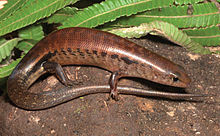
Parvoscincus is a genus of skinks, lizards in the family Scincidae. The genus is endemic to the Philippines.

Parvoscincus leucospilos, the white-spotted sphenomorphus, is a species of skink endemic to the Philippines. It is found between 300 and 1,200 m above sea levels in the forests of central and southern Sierra Madre Mountain Range of Luzon Island. This skink hides under rocks or in debris in the banks of streams and rivers. When threatened by predators, such as snakes, it may dive and stay under water for a long time.

Otosaurus cumingii, commonly called Cuming's sphenomorphus or the Luzon giant forest skink, is a species of skink, a lizard in the family Scincidae. The species is endemic to the Philippines.

Lipinia pulchella, known commonly as the yellow-striped slender tree skink or beautiful lipinia, is a species of skink, a lizard in the family Scincidae. The species is endemic to the Philippines.

Lepidodactylus herrei, known commonly as the Negros scaly-toed gecko or the white-lined smooth-scaled gecko, is a species of gecko, a lizard in the family Gekkonidae. The species is endemic to the Philippines.
Pinoyscincus is a genus of skinks, lizards in the family Scincidae. All species in the genus are endemic to the Philippines. Species in this genus were previously assigned to the genus Sphenomorphus.

Insulasaurus arborens, also known as the Negros sphenomorphus, is a species of lizard of the family of Scincidae. It is endemic to the Philippines.

Eutropis cumingi, also known commonly as Cuming's eared skink, Cuming's mabouya, and Cuming's mabuya, is a species of lizard in the family Scincidae. The species is endemic to the Philippines.

Eutropis englei, also known commonly as Engel's mabuya and the six-striped mabouya, is a species of skink, a lizard in the family Scincidae. The species is endemic to Mindanao in the Philippines.

Insulasaurus wrighti, also known commonly as Wright's sphenomorphus, is a species of skink, a lizard in the family Scincidae. The species is endemic to Palawan in the Philippines.
Parvoscincus beyeri, also known commonly as Beyer's sphenomorphus, is a species of skink, a lizard in the family Scincidae. The species is endemic to the Philippines.
Parvoscincus lawtoni is a species of lizard in the subfamily Sphenomorphinae of the family Scincidae (skinks). The species is endemic to the Philippines.
Parvoscincus tagapayo, the Aurora mountain skink, is a species of lizard in the family Scincidae. The species is endemic to the Philippines.
Pinoyscincus coxi, Cox's sphenomorphus, is a species of skink, a lizard in the family Scincidae. The species is endemic to the Philippines. There are two recognized subspecies.

Pinoyscincus jagori, Jagor's sphenomorphus, is a species of skink, a lizard in the family Scincidae. The species is endemic to the Philippines. There are two recognized subspecies.

Pinoyscincus llanosi, also known commonly as the Leyte sphenomorphus, is a species of skink, a lizard in the family Scincidae. The species is endemic to the Philippines.
The Mindanao sphenomorphus is a species of skink, a lizard in the family Scincidae. The species is endemic to the Philippines.
Tytthoscincus hallieri is a species of skink, a lizard in the family Scincidae. The species is native to Southeast Asia.
Tytthoscincus ishaki, also known commonly as the Tioman Island forest skink, is a species of lizard in the family Scincidae. The species is endemic to Tioman Island in Malaysia.

Brachymeles boulengeri, Boulenger's short-legged skink, is a species of lizard in the family Scincidae. The species is endemic to the Philippines.













